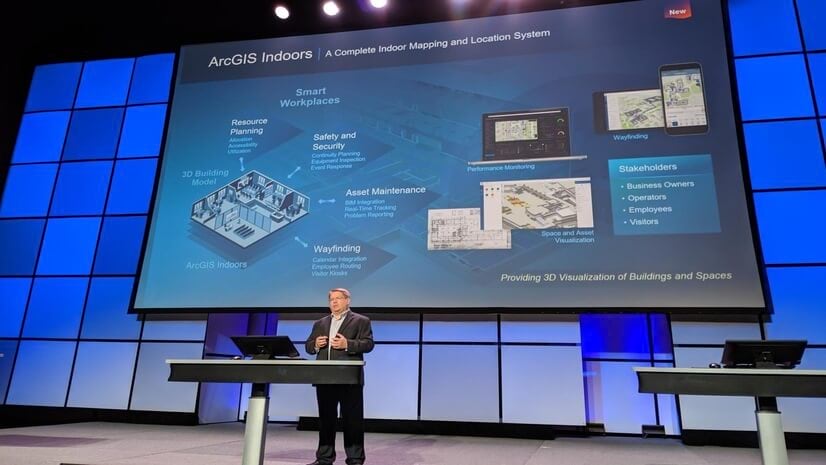If you are working in the GIS industry or have touched on topics such as indoor location-based services or indoor positioning, you will probably also have come across the term “Beacon”. Or you may have noticed these small funny objects mounted on walls inside a building and wondered what they were. Well, you have come to the right place as today we will demystify Beacons.
What is a Beacon?
The Beacons we are talking about in this context are also referred to as BLE/Bluetooth Low Energy Beacons or iBeacons. As the name suggests, they are small radio transmitters, sending out Bluetooth signals to mobile devices in their vicinity.
They are most famously used for indoor positioning, where they provide smartphone users with information about their position within the building, acting as some sort of lighthouse – hence the name “Beacon”.
Ever since the introduction of the BLE (Bluetooth Low Engergy), also known as “Bluetooth Smart” or “Bluetooth 4.0” standard in 2011, energy efficiency has improved significantly compared to regular Bluetooth. BLE is only activated when a connection is established, otherwise it will remain in sleep mode. Moreover, while regular Bluetooth can handle big amounts of data but uses up a lot more energy, Bluetooth Low Energy is typically used when only a small amount of data needs to be transmitted.
This way the smartphone’s battery life will not be affected to any noteworthy extent.
![]()
BLE Beacon mounted on an office wall to enable real-time indoor wayfinding
What do Beacons do?
They are sending out Bluetooth Low Energy signals, transmitting information about their position. These radio signals have a unique ID number and are sent out in regular intervals, i.e. around 10 times per second. The range of a Beacon can vary from 1-150 meters.
Mobile devices in a Beacon’s vicinity can pick up these signals and use them as an indicator for their own location. They then send the ID connected to the signal to the Cloud.
As soon as a mobile application recognizes the BLE signal from the Beacons, the event associated with the Beacon is triggered. This could, for instance, be a push notification that is sent to the smartphone, e.g. a welcome message upon entering the building.
Storing the data in the cloud helps keep the app light and fast and makes it easy to change the content or action connected to the Beacon signal.
Beacons and Indoor Positioning
There are several different technologies on the market today that enable indoor positioning and mobile indoor wayfinding, and Beacon technology is one of them. Due to the relatively low cost involvement and high quality results that can be achieved with this method, it is also one of the most commonly used.
Depending on the building structure and size, the amount of Beacons required varies. Strong adhesive tape has proven as the most efficient means to mount them on the walls – it holds the Beacons well in place, makes them easy to install but also to take down again if needed.
A prerequisite for Beacon-powered indoor positioning to work, is a mobile app and the digital map of the building. This map is created by taking radio recordings of the indoor environment and is then integrated into the mobile app.
With the whole system is in place, the BLE Beacons send out their signal. The smartphone either picks up the signal of the Beacon it is closest to or computes its position based on various Beacons’ signal strengths, allowing the user to position themselves on the map inside the app. The position is shown in real time as a blue dot and provides them with enhanced orientation and mobile navigation inside the building.
What is inside a Beacon?
Beacons come in varying shapes and sizes, but they will all fit easily in the palm of your hand. Although indoor positioning installations usually go with battery powered Beacons, they can also come with a USB port.
On average the battery lasts around three years, before it has to be replaced. To facilitate this process, a Beacon management platform allows you to monitor the battery status of each individual piece of hardware and their location.
![]()
The inner life of a Bluetooth Low Energy Beacon
Due to their compact design, Beacons blend into their surroundings quite easily. Their shapes may vary depending on the provider and colours can be customized. This makes it even easier to hide them from plain sight on the walls and prevent any disruption in the building’s aesthetics.
Whereas other digital devices have a quite complex inner life, Beacons are the complete opposite. In the case of battery powered Beacons, they consist of a lithium chip battery, a CPU and a radio. That is generally all there is to it. Special use cases may require them to also contain an accelerometer, temperature sensors or other unique add-ons, but that is not the norm.
What do Beacons NOT do?
BLE Beacons nowadays are only one-way communicators. That means they transmit signals, but are not able to listen and therefore also not able to perform any actions on their own. Neither can they send you messages, nor collect any information on the smartphone users.
It’s only the mobile app that can trigger actions inside the app when it’s in signal range and when the user consents to receiving push notifications. Beacons can’t track devices or collect third party data – only the app would be able to do that.
Beacons do not drain your phone’s battery. As mentioned above, Beacons are running on Bluetooth Low Energy, which is highly energy efficient and therefore will hardly affect your battery status.
Learn more about how ArcGIS Indoors and IPS use Beacons






Commenting is not enabled for this article.